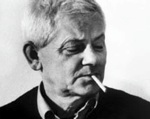
“Writing,” wrote Zbigniew Herbert, “must teach men soberness: to be awake.” One of Poland’s greatest poets, Herbert (1924–1998) was also a prolific essayist, and with the publication of his Collected Prose this week we can take in the full range of his brisk, erudite work. As Charles Simic, who has written about Herbert in our pages, notes in his preface to the book, “Herbert never had much money, but he went everywhere, at one point even having the crazy notion of visiting every cathedral in France. As a foreigner, and a kind of amateur scholar, he sees in art works what professional academics and natives do not. We are led by an eye that reacts in a fresh and inspired way to objects and events that do not exist for the practical eye.” What follows is drawn from the new book; many of the pieces in it are appearing in English for the first time.
I THINK HE OFTEN repeated to himself the phrase “O Leonardo, why do you labor so?”—he who was able to look at himself from the perspective of “frozen time.”
It appears the whole restless labor of his life was overcome by a pure and controlled art. And yet his painting is filled with disquiet.
Leonardo’s disquiet—what do you mean? Haven’t his paintings been punctured with compasses, covered with networks of lines to prove the geometrical wisdom of his compositions, the balance of the spatial forms and the quietude of the isoceles triangles? Michelangelo is a different story, but Leonardo seems to dwell in the very self-enchanted and self-satisfied heart of the Renaissance. And yet his painting is filled with disquiet.
Leda, the Gioconda, Benci, angels and women, goddesses and Madonnas; do you understand their smiles and the look in their widely set eyes? And the rocks, plants, and trees, the cold green waters, streams, and air—(how strangely he painted the early evening air).
So many questions, so many mysteries, or if that term irritates your reason—so many problems. And though it is a wise and self-conscious art, his painting is filled with disquiet.
LEONARDO THE PAINTER was the first to strive for a liberation of the arts. He dared to demand comparisons of painting with the other arts. With the zeal of one who reviles an age-old wrong, he raised painting above poetry. His argument was naïve: the eye is a nobler sense than the ear; and the next argument, a little more substantial: the superiority of the image of nature to its description, of form to expression.
But trampling on poetry wasn’t enough for him. He wrote of the superiority of painting to philosophy. And because the artist is a pupil of nature, he stands next to the student of nature. You see yourselves what going beyond your own discipline leads to.
Leonardo wanted to contain in his paintings the moods and emotions of poetry, the wisdom of science and philosophy. He, who warned himself that “one should not desire the impossible,” it seems, desired it above all things. He is the Great Usurper.
Looking at the paintings of Watteau, Chardin, Renoir, you see that they possess the same beauty of surface, the same tranquillity, the same grace of color. Leonardo knew too much for a painter. It seems that painting his beautiful heads, he couldn’t free himself from the thought of the skull, the brain, the network of veins, of everything he learned from the autopsy of corpses. Shouldn’t a painter know only the skin of the world? At every step, Leonardo the painter was ambushed by Leonardo the anatomist. And hence the sad wisdom and the melancholy of knowledge in his paintings.
Among his writings there is a fragment that seems not only an excellent introduction to the Madonna of the Rocks but also a commentary on his whole art:
“… often lost amid shadowy rocks, I came to discover a great cave, before which I, standing, somewhat astonished and unknowing of such things, with my back bent in an arch and my weary hand leaning on one knee, I covered my lowered and half-closed eyelids with my right hand.
“And when I stood there a moment, leaning here and there to see whether there were not something hidden from me by the great darkness reigning inside the cave, suddenly two forces awoke in me, fear and desire; fear of the terrifying dark cave, and desire to look if there was some extraordinary thing inside.”
Let us repeat: fear and desire. That is the formula for Leonardo’s disquiet.
The peculiarity of Leonardo’s disquiet is that it does not manifest itself in violent gestures. It is disquiet that respects the line, disquiet controlled and therefore doubly disquieting. How great is it and how great is he who mastered it.
Advertisement
And one more thing: “if there was some extraordinary thing”—is written by the same man who said “every thing derives from every thing, every thing becomes every thing, every thing returns to every thing,” the man who wrote a treatise on the elements and wanted to catch nature in a net of causes. Fear and desire of an extraordinary thing.
O Leonardo, what do you so infinitely desire?
Translated by Alissa Valles
From the book The Collected Prose: 1948-1998 by Zbignew Herbert. Copyright © 2010 by The Estate of Zbigniew Herbert. Reprinted by arrangement with Ecco, an imprint of HarperCollins Publishers.



